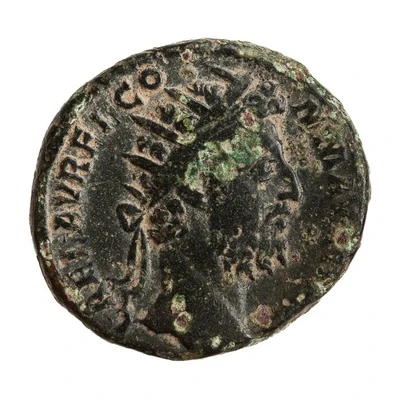


© American Numismatic Society (ANS)
Dupondius - Commodus P M TR P XVII IMP VIII COS VII P P S C; Fortuna
192 year| Bronze | 13.2 g | 25 mm |
| Issuer | Rome › Roman Empire (27 BC - 395 AD) |
|---|---|
| Emperor | Commodus (Lucius Aurelius Commodus) (177-192) |
| Type | Standard circulation coin |
| Year | 192 |
| Value | 1 Dupondius = ⅛ Denarius |
| Currency | Denarius, Reform of Augustus (27 BC – AD 215) |
| Composition | Bronze |
| Weight | 13.2 g |
| Diameter | 25 mm |
| Shape | Round (irregular) |
| Technique | Hammered |
| Demonetized | Yes |
| Updated | 2024-10-06 |
| Numista | N#266017 |
|---|---|
| Rarity index | 100% |
Reverse
Fortuna, draped, standing left, foot on prow, holding caduceus in right hand and double cornucopiae in left hand; in field, star.
Script: Latin
Lettering: P M TR P XVII IMP VIII COS VII P P S C
Translation:
Pontifex Maximus, Tribunicia Potestate Septima Decima, Imperator Octavum, Consul Septimum, Pater Patriae. Senatus Consultum.
High priest, holder of tribunician power for the 17th time, supreme commander (Imperator) for the eighth time, consul for the seventh time, father of the nation. Decree of the senate.
Comment
Mass varies: 11.35–15.13 g;Example of this type:
American Numismatic Society (ANS)
Source:
Online Coins of the Roman Empire (OCRE)
Interesting fact
The Dupondius coin was a common denomination in the Roman Empire during the reign of Commodus (180-192 AD). It was made of bronze and weighed 13.2 grams, as . What's interesting is that the coin's design features Fortuna, the Roman goddess of luck and prosperity, on the reverse side. This suggests that the coin was intended to bring good fortune to its owner, which was a common belief in ancient Rome. Additionally, the coin's obverse side features an image of Commodus, which was a common practice in Roman coinage to display the ruling emperor's image on coins. Overall, this coin provides a fascinating glimpse into the currency and beliefs of ancient Rome during the 2nd century AD.